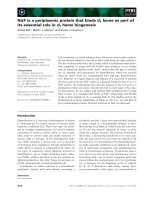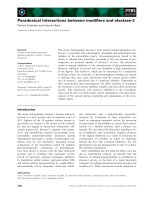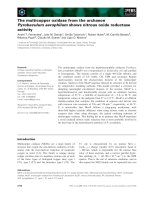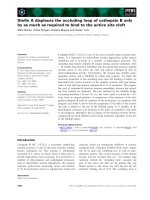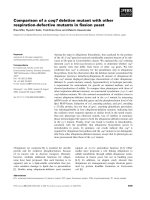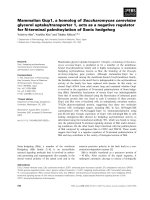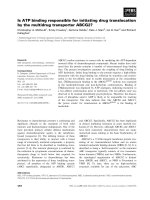Tài liệu Báo cáo khoa học: "Dialog Navigator : A Spoken Dialog Q-A System based on Large Text Knowledge Base" docx
Bạn đang xem bản rút gọn của tài liệu. Xem và tải ngay bản đầy đủ của tài liệu tại đây (53.85 KB, 4 trang )
Dialog Navigator : A Spoken Dialog Q-A System
based on Large Text Knowledge Base
Yoji Kiyota, Sadao Kurohashi (The University of Tokyo)
kiyota,kuro @kc.t.u-tokyo.ac.jp
Teruhisa Misu, Kazunori Komatani, Tatsuya Kawahara (Kyoto University)
misu,komatani,kawahara @kuis.kyoto-u.ac.jp
Fuyuko Kido (Microsoft Co., Ltd.)
Abstract
This paper describes a spoken dialog Q-
A system as a substitution for call centers.
The system is capable of making dialogs
for both fixing speech recognition errors
and for clarifying vague questions, based
on only large text knowledge base. We in-
troduce two measures to make dialogs for
fixing recognition errors. An experimental
evaluation shows the advantages of these
measures.
1 Introduction
When we use personal computers, we often en-
counter troubles. We usually consult large manu-
als, experts, or call centers to solve such troubles.
However, these solutions have problems: it is diffi-
cult for beginners to retrieve a proper item in large
manuals; experts are not always near us; and call
centers are not always available. Furthermore, op-
eration cost of call centers is a big problem for en-
terprises. Therefore, we proposed a spoken dialog
Q-A system which substitute for call centers, based
on only large text knowledge base.
If we consult a call center, an operator will help
us through a dialog. The substitutable system also
needs to make a dialog. First, asking backs for fixing
speech recognition errors are needed. Note that too
many asking backs make the dialog inefficient. Sec-
ondly, asking backs for clarifying users’ problems
are also needed, because they often do not know
their own problems so clearly.
To realize such asking backs, we developed a sys-
tem as shown in Figure 1. The features of our system
are as follows:
Precise text retrieval.
The system precisely retrieves texts from large
confirmation using
confidence in recognition
confirmation using
significance for retrieval
automatic speech recognizer
(Julius)
speech input
confirmation for
significant parts
user’s selection
N-best candidates
(or reject all)
user’s selection
N-best candidates of speech recognition
asking back(s)
with dialog cards
description extraction
choices in
dialog cards
user’s selection
final result
retrieval result text
retrieval
systemuser
text
knowledge
base
dialog for clarifying
vague questions
dialog
cards
dialog for fixing
speech recognition
errors
Figure 1: Architecture.
text knowledge base provided by Microsoft
Corporation (Table 1), using question types,
products, synonymous expressions, and syntac-
tic information. Dialog cards which can cope
with very vague questions are also retrieved.
Dialog for fixing speech recognition errors.
When accepting speech input, recognition er-
rors are inevitable. However, it is not obvi-
ous which portions of the utterance the sys-
tem should confirm by asking back to the user.
A great number of spoken dialog systems for
particular task domains, such as (Levin et al.,
2000), solved this problem by defining slots,
but it is not applicable to large text knowledge
base. Therefore, we introduce two measures
of confidence in recognition and significance
for retrieval to make dialogs for fixing speech
recognition errors.
Dialog for clarifying vague questions.
When a user asks a vague question such as
“An error has occurred”, the system navigates
him/her to the desired answer, asking him/her
back using both dialog cards and extraction of
Table 1: Text collections.
# of # of matching
text collection
texts characters target
Glossary 4,707 700,000 entries
Help texts
11,306 6,000,000 titles
Support KB
23,323 22,000,000 entire texts
summaries that makes differences between re-
trieved texts more clear.
Our system makes asking backs by showing them
on a display, and users respond them by selecting
the displayed buttons by mouses.
Initially, we developed the system as a keyboard
based Q-A system, and started its service in April
2002 at the web site of Microsoft Corporation. The
extension for speech input was done based on the
one-year operation. Our system uses Julius (Lee et
al., 2001) as a Japanese speech recognizer, and it
uses language model acquired from the text knowl-
edge base of Microsoft Corporation.
In this paper, we describe the above three features
in Section 2, 3, and 4. After that, we show experi-
mental evaluation, and then conclude this paper.
2 Precise Text Retrieval
It is critical for a Q-A system to retrieve relevant
texts for a question precisely. In this section, we
describe the score calculation method, giving large
points to modifier-head relations between bunsetsu
1
based on the parse results of KNP (Kurohashi and
Nagao, 1994), to improve precision of text retrieval.
Our system also uses question types, product names,
and synonymous expression dictionary as described
in (Kiyota et al., 2002).
First, scores of all sentences in each text are calcu-
lated as shown in Figure 2. Sentence score is the to-
tal points of matching keywords and modifier-head
relations. We give 1 point to a matching of a key-
word, and 2 points to a matching of a modifier-head
relation (these parameters were set experimentally).
Then sentence score is normalized by the maximum
matching score (MMS) of both sentences as follows
(the MMS is the sentence score with itself):
sentence score
the MMS of a
user question
the MMS of a
text sentence
1
Bunsetsu is a commonly used linguistic unit in Japanese,
consisting of one or more adjoining content words and zero or
more following functional words.
Outlook
‘Outlook’
tsukau
‘use’
meru
‘mail’
jushin
‘receive’
Outlook wo tsukatte
meru wo jushin dekinai.
‘I cannot receive mails using Outlook.’
Outlook
‘Outlook’
‘mail’
jushin
‘receive’
error
‘error’
Outlook de meru wo jushin
suru sai no error.
‘An error while receiving mails
using Outlook.’
+1
+1
+1
MMS810
user question text sentence
meru
+2
sentence score
= 5
Figure 2: Score calculation.
vague
concrete
Error ga hassei shita.
‘An error has occurred.’
Komatte imasu.
‘I have a problem.’
Windows 98 de kidouji ni
error ga hassei shita.
‘An error has occurred
while booting Windows 98.’
text knowledge base
clarifying questions
using dialog cards
text retrieval &
description extraction
user
questions
Figure 3: User navigation.
Finally, the sentence that has the largest score in
each text is selected as the representative sentence of
the text. Then, the score of the sentence is regarded
as the score of the text.
3 Dialog Strategy for Clarifying Questions
In most cases, users’ questions are vague. To cope
with such vagueness, our system uses the following
two methods: asking backs using dialog cards and
extraction of summaries that makes difference be-
tween retrieved texts more clear (Figure 3).
3.1 Dialog cards
If a question is very vague, it matches many texts,
so users have to pay their labor on finding a rele-
vant one. Our system navigates users to the desired
answer using dialog cards as shown in Figure 3.
We made about three hundred of dialog cards
to throw questions back to users. Figure 4 shows
two dialog cards.
UQ (User Question) is fol-
lowed by a typical vague user question. If a user
question matches it, the dialog manager asks the
back question after
SYS , showing choices be-
[Error]
UQ Error ga hassei suru
‘An error occurs’
SYS Error wa itsu hassei shimasuka?
‘When does the error occurs?’
SELECT
Windows kidou ji goto [Error/Booting Windows]
‘while booting Windows’
in’satsu ji goto [Error/Printing Out]
‘while printing out’
application kidou ji goto [Error/Launching Applications]
‘while launching applications’
/SELECT
[Error/Booting Windows]
UQ Windows wo kidou ji ni error ga hassei suru
‘An error occurs while booting Windows’
SYS Anata ga otsukai no Windows wo erande kudasai.
‘Choose your Windows.’
SELECT
Windows 95 retrieve Windows 95 wo kidou ji ni error ga hassei suru
‘An error occurs while booting Windows 95’
Windows 98 retrieve Windows 98 wo kidou ji ni error ga hassei suru
‘An error occurs while booting Windows 98’
Windows ME retrieve Windows ME wo kidou ji ni error ga hassei suru
‘An error occurs while booting Windows ME’
/SELECT
Figure 4: Dialog cards.
tween
SELECT and /SELECT . Every choice is
followed by
goto or retrieve. goto means that the
system follow the another dialog cards if this choice
is selected.
retrieve means that the system retrieve
texts using the query specified there.
3.2 Description extraction from retrieved texts
In most cases, the neighborhood of the part that
matches the user question describes specific symp-
toms and conditions of the problem users encounter.
Our system extracts such descriptions from the re-
trieved texts as the summaries of them. The algo-
rithm is described in (Kiyota et al., 2002).
4 Dialog Strategy for Speech Input
It is necessary for a spoken dialog system to deter-
mine which portions of the speech input should be
confirmed. Moreover, criteria for judging whether
it should make confirmation or not are needed, be-
cause too many confirmations make the dialog inef-
ficient. Therefore, we introduce two criteria of con-
fidence in recognition and significance for retrieval.
Our system makes two types of asking backs for
fixing recognition errors (Figure 1). First, Julius out-
puts
-best candidates of speech recognition. Then,
the system makes confirmation for significant parts
based on confidence in recognition. After that, the
system retrieves relevant texts in the text knowledge
base using each candidate, and makes confirmation
based on significance for retrieval.
4.1 Confidence in recognition
We define the confidence in recognition for each
phrase in order to reject partial recognition errors. It
is calculated based on word perplexity, which is of-
ten used in order to evaluate suitability of language
models for test-set sentences. We adopt word per-
plexity because of the following reasons: incorrectly
recognized parts are often unnatural in context, and
words that are unnatural in context have high per-
plexity values.
As Julius uses trigram as its language model, the
word perplexity
is calculated as follows:
s are summed up in each bunsetsu (phrases).
As a result, the system assigned the sum of
s
to each bunsetsu as the criterion for confidence in
recognition.
We preliminarily defined the set of product names
as significant phrases
2
. If the sums of s for any
significant phrases are beyond the threshold (now,
we set it 50), the system makes confirmation for
these phrases.
4.2 Significance for retrieval
The system calculates significance for retrieval us-
ing
-best candidates of speech recognition. Be-
cause slight speech recognition errors are not harm-
ful for retrieval results, we regard a difference that
affects its retrieval result as significant. Namely,
when the difference between retrieval results for
each recognition candidate is large, we regard that
the difference is significant.
Significance for retrieval is defined as a rate
of disagreement of five high-scored retrieved texts
among
recognition candidates. For example, if
there is a substituted part in two recognition candi-
dates, and only one text is commonly retrieved out
of five high-scored texts by both candidates, the sig-
nificance for retrieval for the substituted part is 0.8
(
).
The system makes confirmation which candidate
should be used, if significance for retrieval is beyond
the threshold (now, we set it 0.5).
2
We are now developing a method to define the set of sig-
nificant phrases semi-automatically.
Table 2: Number of successful retrieval for each speaker.
speaker #of ASR transcription speech recognition with confidence with significance with both
ID
utterances corr. (1) results (2) in recognition (3) for retrieval (4) measures (5)
A 13 87.8% 10/13 8/13 8/13 10/13 10/13
B 14 55.0% 6/14 3/14 5/14 3/14 5/14
C 13 61.7% 5/13 5/13 5/13 5/13 5/13
D 13 83.1% 11/13 9/13 9/13 9/13 9/13
total 53 68.5% 32/53 25/53 27/53 27/53 29/53
U: OS は ME なのですが、使うには問題ないんですけれども、閉じるや最
大化ボタンの表示が 、えー 、おかしな表示になってるんですけれど、ど
うにかならないんでしょうか
‘I am using (Windows) ME as OS(operating system), then ’
ASR: OS を IME のですが 疲れ問題ないんですけど も太字や最大化ボタンの表
示がへおかしな表示になってるんですよど ういかがでしょか
(“ME” was incorrectly recognized as “IME”.)
S: The underlined product name seems to be uncorrectly recognized. May I
remove it, or leave it?
U: (selected “remove”)
S: The following texts are retrieved.
1. [AC97] フォームを最大化したときに [閉じ る] ボタンを非表示にする
2. [拡大鏡の設定] で [最大化] ボタンが使用できない
3. [WinMe] TrueType フォント キャッシュが破壊される (a correct answer)
U: Word 2002 で数式を入力する方法を教えてください
“Please tell me the way to input formulas in Word 2002.”
ASR: 1. Word 2002 で数字(numbers) を入力する方法を教えてください
2. Word 2002 で数式(formulas) を入力する方法を教えてください
3. Word 2002 で数値(values) を入力する方法を教えてください
S: Please select the most correct recognition result from the above candidates.
U: (selected No. 2)
S: The following texts are retrieved.
1. Word で数式を挿入する (a correct answer)
2. Word で現在の日付と時刻を入力する
3. スプレ ッド シート で数式を入力する
Figure 5: Dialogs for fixing speech recognition er-
rors.
(U: user, S: system, ASR: automatic speech recognition)
5 Experimental Evaluation
We evaluated the system performance experimen-
tally. For the experiments, we had 4 subjects, who
were accustomed to using computers. They made
utterances by following given 10 scenarios and also
made several utterances freely. In total, 53 utter-
ances were recorded. Figure 5 shows two successful
dialogs by confirmation using confidence in recog-
nition and by that using significance for retrieval.
We experimented on the system using the 53
recorded utterances by the following methods:
(1) Using correct transcription of recorded utter-
ance, including fillers.
(2) Using speech recognition results from which
only fillers were removed.
(3) Using speech recognition results and making
confirmation by confidence in recognition.
(4) Using
-best candidates of speech recognition
and making confirmation by significance for re-
trieval. Here,
.
(5) Using
-best candidates of speech recognition
and both measures in (3) and (4).
In these experiments, we assumed that users al-
ways correctly answer system’s asking backs. We
regarded a retrieval as a successful one if a relevant
text was contained in ten high-scored retrieval texts.
Table 2 shows the result. It indicates that our
confirmation methods for fixing speech recognition
errors improve the success rate. Furthermore, the
success rate with both measures gets close to that
with the transcriptions. Considering that the speech
recognition correctness is about 70%, the proposed
dialog strategy is effective.
6 Conclusion
We proposed a spoken dialog Q-A system in which
asking backs for fixing speech recognition errors and
those for clarifying vague questions are integrated.
To realize dialog for fixing recognition errors based
on large text knowledge base, we introduced two
measures of confidence in recognition and signif-
icance for retrieval. The experimental evaluation
shows the advantages of these measures.
References
Yoji Kiyota, Sadao Kurohashi, and Fuyuko Kido. 2002.
“Dialog Navigator” : A Question Answering System
based on Large Text Knowledge Base. In Proceedings
of COLING 2002, pages 460–466.
Sadao Kurohashi and Makoto Nagao. 1994. A syntactic
analysis method of long Japanese sentences based on
the detection of conjunctive structures. Computational
Linguistics, 20(4).
A. Lee, T. Kawahara, and K. Shikano. 2001. Julius – an
open source real-timelarge vocabulary recognition en-
gine. In Proceedings of European Conf. Speech Com-
mun. & Tech. (EUROSPEECH), pages 1691–1694.
E. Levin, S. Narayanan, R. Pieraccini, K. Biatov,
E. Bocchieri, G. Di Fabbrizio, W. Eckert, S. Lee,
A. Pokrovsky, M. Rahim, P. Ruscitti, and M. Walker.
2000. The AT&T-DARPA communicator mixed-
initiative spoken dialogue system. In Proceedings of
Int’l Conf. Spoken Language Processing (ICSLP).

